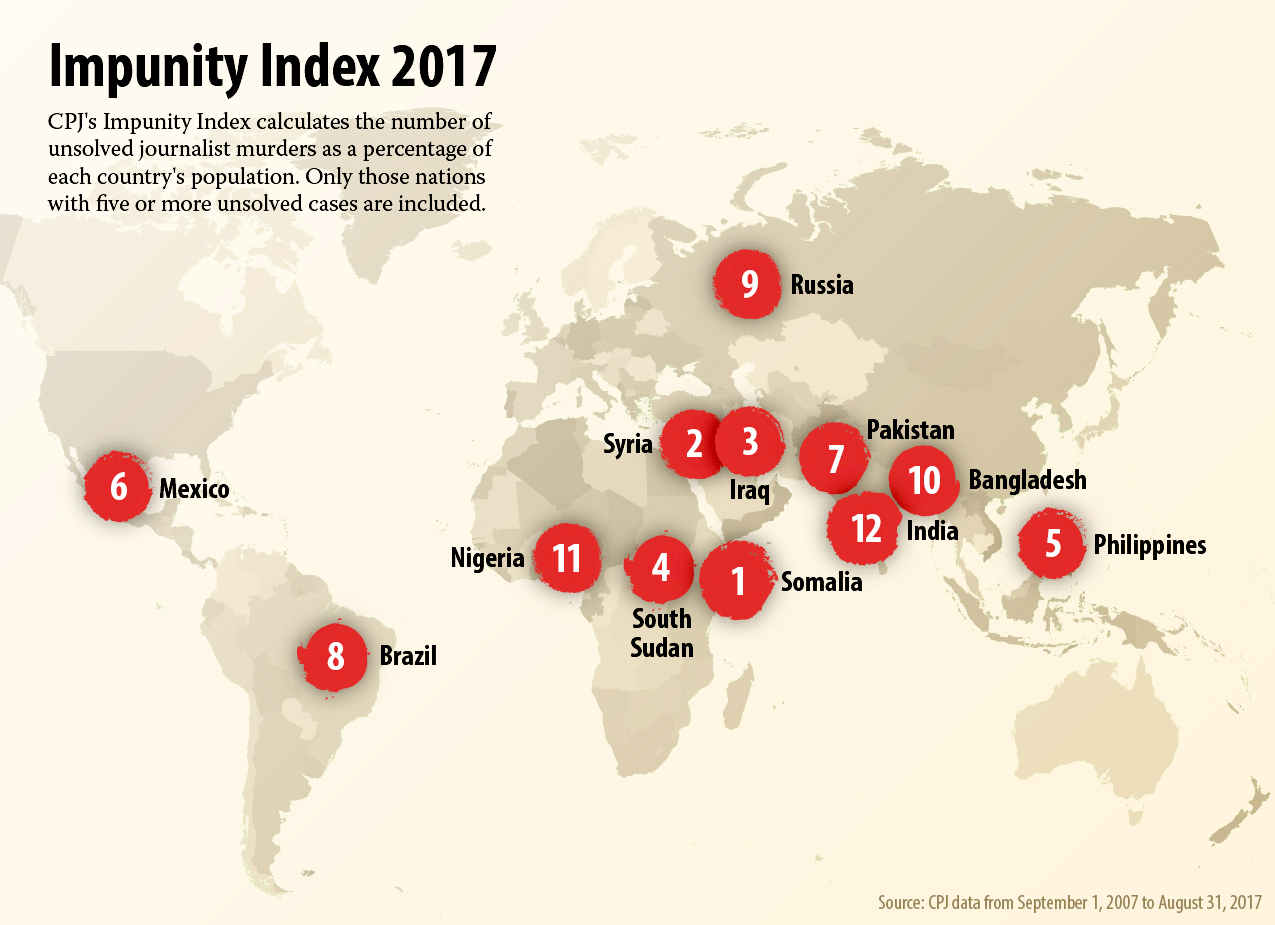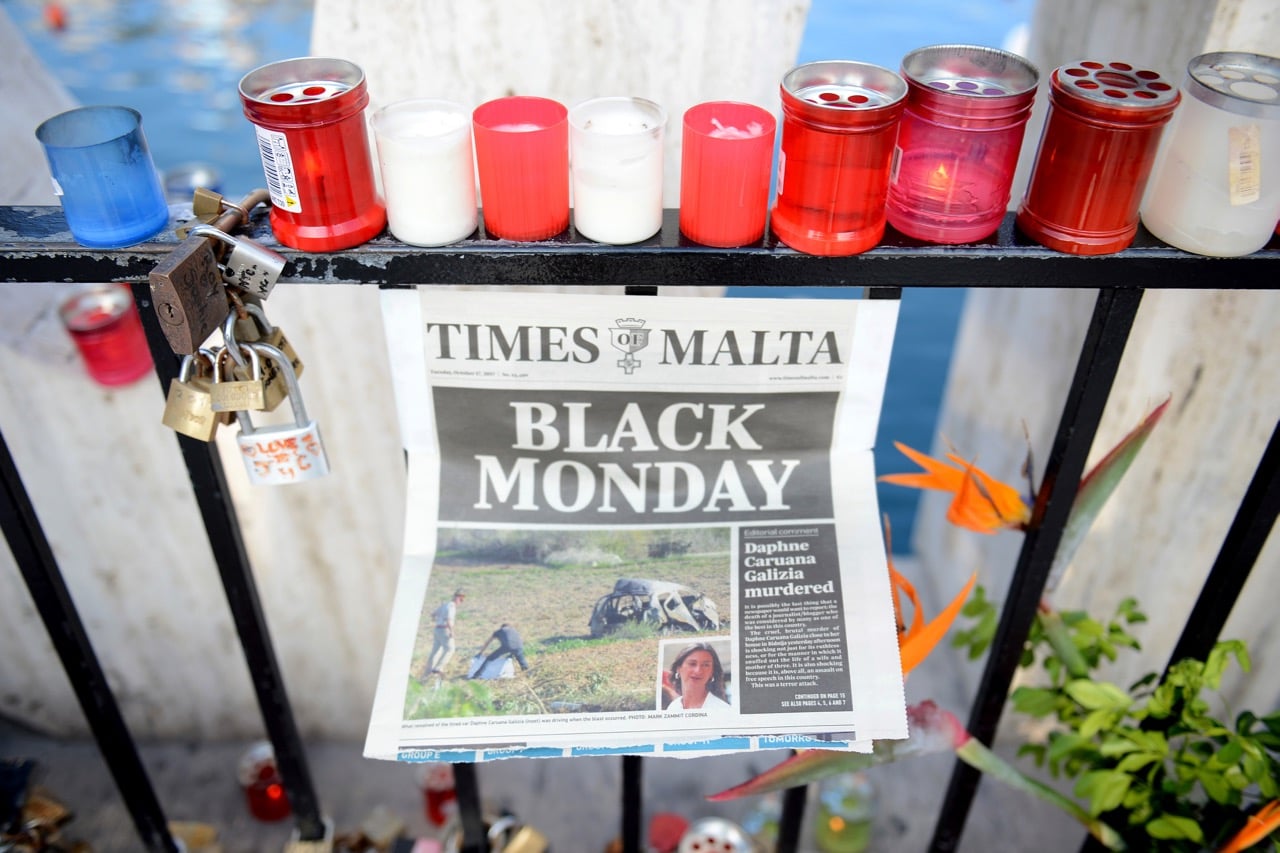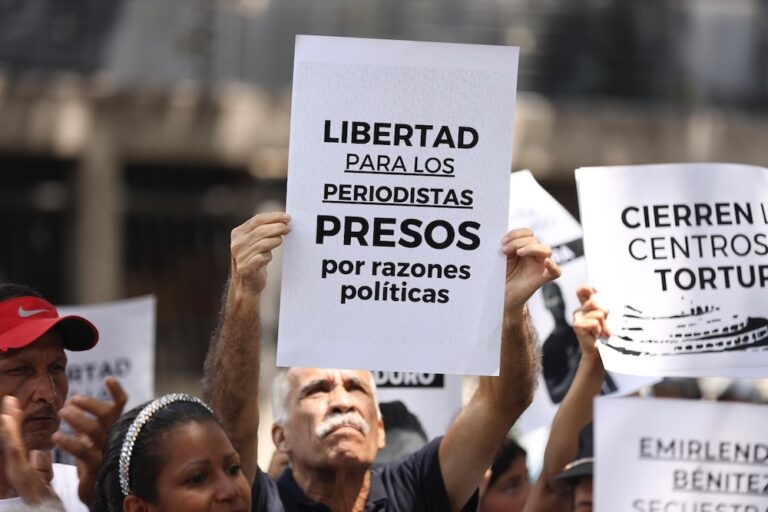What 12 countries account for 80% of unsolved journalist murders? How often are journalists' killers found? This year's CPJ Index provides crucial information to help keep governments accountable in the fight against impunity.
This statement was originally published on cpj.org on 31 October 2017.
By Elisabeth Witchel, CPJ Impunity Campaign Consultant
Impunity in the murders of journalists can be an intractable cycle stretching over a decade or more, according to the Committee to Protect Journalists’ 10th annual Global Impunity Index, a ranking of countries where journalists are murdered and their killers go free. Seven countries on this year’s index have been listed every year since the index launched a decade ago – including Somalia, which is the worst country for unsolved murders for the third year in a row.
Impunity thrives in conflict environments, where powerful actors often use violent intimidation to control media coverage, while weak-to-nonexistent law and order increases the likelihood of attacks. Justice for over two dozen journalists murdered in Somalia in the past decade is one casualty of prolonged civil war and an insurgency waged by al-Shabaab extremists.
The war in Syria pushed that country into the second worst spot on the index, compared with third last year. Third on this year’s index is Iraq, where journalists are menaced by the militant group Islamic State and state-backed militias, among other groups.
Fighting between political factions in South Sudan, number four on the index, is the backdrop behind a 2015 ambush during which five journalists were killed. Threats from violent extremist groups operating beyond the reach of authorities underpin high impunity rates in three other countries on the index: Pakistan, Bangladesh, and Nigeria.
Afghanistan dropped off the list for the first time since CPJ began calculating the index in 2008. Though security conditions remain volatile and no convictions in journalist murders were achieved, targeted killings of journalists have declined. Instead, larger-scale acts of violence such as a truck bomb attack in downtown Kabul in May that killed 150 people, including one journalist, are responsible for recent fatalities. Over a dozen journalists have been killed there in the past decade while covering combat, by crossfire, or while covering dangerous assignments. CPJ records only two murders, both unsolved, for the period covered by this index.
The Impunity Index, published annually to mark the International Day to End Impunity for Crimes against Journalists on November 2, calculates the number of unsolved murders over a 10-year period as a percentage of each country’s population. For this edition, CPJ analyzed journalist murders in every nation that took place between September 1, 2007 and August 31, 2017. Only those nations with five or more unsolved cases for the period are included on the index-a threshold that 12 countries met this year, compared with 13 last year. Read more about CPJ’s methodology.
Conflict is not the only cause of impunity. In countries such as the Philippines, Mexico, Brazil, Russia, and India-countries that bill themselves as democracies but have repeatedly appeared on the index-government officials and criminal groups go unpunished for murdering journalists in high numbers.
Over the decade that CPJ has published the Global Impunity Index, Somalia’s impunity rating shot up by 198 percent. Other countries that saw impunity ratings increase the most over the past decade are: Mexico (142 percent), Pakistan (113 percent), and India (100 percent); Syria (up 195 percent) and Brazil (up 177 percent) experienced huge increases in impunity despite not appearing on the index all 10 years.
In addition to Afghanistan, four countries that appeared on the index have come off at various times since 2008: Colombia, Sierra Leone, Sri Lanka, and Nepal. Their exit from the list is attributable primarily to declines in violence associated with the end of civil wars rather than with prosecutions being achieved. Only Colombia and Nepal convicted the perpetrators of journalist killings, and only in a handful of cases.
International attention to the issue of impunity in journalist murders has increased in the past 10 years. The United Nations has adopted a total of five resolutions–three by the Human Rights Council, one by the General Assembly and the one by the Security Council–urging states to take measures to promote justice when journalists are attacked. This year also marked the fifth anniversary of the adoption of the U.N. Plan of Action for the Safety of Journalists and the Issue of Impunity.
This year, 23 states responded to the UNESCO director general’s request for information on
the status of investigations into killed journalists, including eight countries on this index. Pakistan acknowledged receipt of the request, but did not provide information. Three index countries-India, South Sudan, and Syria-failed to respond at all. CPJ and other press freedom groups advocate for full participation by all states in this accountability mechanism.
Among the other findings from CPJ’s data on murdered journalists:
– The 12 countries on the index account for nearly 80 percent of the unsolved murders that took place worldwide during the 10-year period ending August 31, 2017.
– Four countries on this year’s index-India, Mexico, Nigeria, and the Philippines-are on the governing council of the Community of Democracies, a coalition dedicated to upholding and strengthening democratic norms.
– In five countries listed on the index, new murders took place over the past year, a testimony to the powerful cycle of impunity and violence.
– Political groups, including Islamic State and other extremist organizations, are the suspected perpetrators in one third of murder cases. Government and military officials are considered the leading suspects in about a quarter of the murders.
– About 93 percent of murder victims are local reporters. The majority cover politics and corruption in their home countries.
– In at least 40 percent of cases, murder victims reported receiving threats before they were killed, highlighting the need for robust protection mechanisms.
– In only 4 percent of total murder cases has there been full justice, including prosecution of those who commissioned the crime.
– In the past 10 years, around 30 percent of murdered journalists were first taken captive-higher than the historical average of 22 percent since CPJ began tracking in 1992. The majority of those taken captive are tortured, sending a chilling message to the victims’ colleagues.
Click here to read the full report.

Impunity Index MapCPJ



